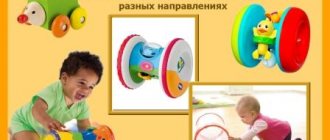You probably won’t find a mother in the world who wouldn’t dream of the day when her beloved little one will ask to relieve himself in the potty. Goodbye disposable diapers! Hello, adulthood! But for some reason, everything is not as simple as we would like. It turns out that a lot of effort needs to be made for this miracle to happen. How to potty train a child at 1 year old? After all, according to statistics, it is at this age that most children begin to learn toilet science. Or should we pay attention to this issue even earlier? And how should you properly train your little ones so that the results don’t take long to arrive? What do child psychologists think about this?
- 2 When is it better to wait for innovations?
- 3 Select the main attribute
3.1 What should you pay attention to when purchasing?
When is a child ready to learn toilet skills?
And psychologists are sure that even if you start putting a child on the potty at 8-9 months, and he successfully empties into it, then we are talking only about a reflex, and not about a conscious acquired skill.
There is no point in talking about any control over urination at this age. For the simple reason that the baby’s nervous system is not yet developed enough for this.
Children begin to control the processes of urination and defecation no earlier than they are 18 months old, or even later.
A child begins to control the processes of urination and defecation from approximately 18 months. Which is justified physiologically. Therefore, you should think about starting a baby’s toilet education no earlier than he turns 1 year old.
Of course, you can start introducing the baby to the potty before the age of one, but, as many have seen in practice, you will simply increase the training time.
Both children whose parents used early planting and children who began to learn to go to the potty at one and a half years old begin to consciously control their bowel movements at the same age (at 18 months - 2.5 years during the day, and at 3-3 .5 years – at night).
And this has nothing to do with learning. It's all about the readiness of the child's nervous system. Another thing is that there are no identical children. And everyone develops according to their own schedule. Mom and dad shouldn't worry about this at all. Sooner or later, all toddlers start peeing and pooping in the potty.
To start potty training your child, make sure he is fully physically and psychologically ready.
What signs may indicate that a child is ready to begin learning “potty science”?
- The baby sits up and walks independently.
- He can take off and put on his pants himself.
- The baby is already able to inform his parents about his desires using words or gestures.
- The child successfully imitates his elders.
- Understands when requests are made to him.
- Follows adult directions.
- And shows interest in praise and encouragement from mom and dad.
If all this is about your baby, then it’s time for him to give up diapers and start managing his needs, almost like an adult.
You can start potty training your baby if he is completely psychologically ready. In addition, the baby must be completely healthy physically
Cartoons and songs to help potty train your child
Potty training a child is one of the most important, but at the same time difficult tasks for any parent. When should you start “training” and what methods will be most effective for your baby?
Source: instagram @kidmag_official
Pediatricians and psychologists recommend starting to think about potty training a child no earlier than he is physiologically mature for this. That is, the child must have the physiological ability to control the urge to urinate and defecate - to understand when an important moment is approaching and be able to restrain it, that is, endure it. This happens after a year, gradually and very individually - for some at a year and a half, for others at two and a half.
There are a huge number of potty training methods. Each mother has her own experience in potty training her baby, and pediatricians and psychologists give their recommendations. We bring to your attention 5 educational cartoons and songs that can help your child cope with this problem.
An educational cartoon from the Little Baby Bum company, in which Baby Panda talks about how she learns to use the potty.
In such a difficult task as potty training, all means are good, but parents should remember: if the baby still doesn’t succeed, just wait, return to the usual diapers, and then try again.
Children's educational song from the fun musical project Kukutiki
Be patient and don’t scold your child – learning this important skill takes time. If you can't get him to sit on the potty, return his diaper, but explain that it's wrong and he's old enough to use the potty.
Without panic and hysteria: why the baby won’t sit on the potty
A funny cartoon from the Happy Kids channel, in which a bunny tells kids how to use the potty correctly
Don’t give up diapers abruptly; they can still be useful for quite a long time: during walks or long trips, at night, during illness or sleeping outside the home. It is also important to understand that a child learns to go to the potty while awake much earlier than waking up to do this during sleep, especially at night.
Cartoon about a little princess learning to go potty from the LieveLive channel
Mom needs to remember that it makes sense to put the baby on the potty only when he clearly wants to go to the toilet. Keeping a baby on the potty just like that doesn’t make sense.
Little kids. Potty training series
Parents need to know that the process of complete weaning from diapers can take about a year, or even more, depending on the baby’s desire and the right parenting tactics, so be patient.
When is it better to wait for innovations?
- But do not rush into any innovations if the child is sick or has just recently suffered from some illness. Let the baby recover.
- If any changes occur in your family (the birth of another child, a change of place of residence, a crisis in family relationships, etc.), then it is also better to temporarily abandon actively teaching your child new skills.
- Well, and, of course, if you see that your little one does not have any of the above signs of readiness, wait to potty train your baby until they appear.
Always remember that your child is an individual. He is not like any other baby. So why should he start going potty when the neighbor's little one does? Don't look up to anyone. Start only from the physical and psychological readiness for training of your little one.
Potty for girls
Potty training your baby step by step
- Place the potty you bought in your child’s room and try to clearly explain to the baby what this new item is and why it is needed.
- If the baby is not immediately imbued with any good feelings towards what he considers an outlandish thing, just give him time to take a closer look and get used to finding the potty on his territory. If the little one reacted quite kindly to his first toilet device, you can move on to the next stage.
- Place your child on the potty for a few minutes 2-3 times during the day. In this case, you do not need to take off your panties (diaper) yet. Just let the baby begin to take the potty for granted. This stage usually takes 7-10 days.
Be patient and kind. Otherwise, you risk causing persistent rejection and protest in your little one.
- Then you can try to plant the baby without pants (diaper) 2-3 times a day. At the same time, do not try to catch when the baby wants to pee. So you can only scare him. And the child, on the contrary, will try to hold back urination while sitting on the potty. But you are striving for the exact opposite. Therefore, there is no need to rush. Let everything take its course. Allow at least 1-2 weeks for this stage.
- During which you can try to more clearly form in the toddler’s mind an idea of the purpose of the potty. How to do it? Every time you take your baby's diaper off, you can defiantly throw it into the potty. You can ask the older child to relieve himself in the potty in front of the younger one. After all, kids very willingly imitate their elders. And this method very often turns out to be the most effective. Do not forget to constantly explain all your actions to your baby. You shouldn’t underestimate the power of words, even if it seems to you that the little one doesn’t understand everything. This will take another 1-2 weeks.
- Now you can start putting your child on the potty when it seems to you that he really needs it. For example, after sleep, food, walk. Watch the baby carefully. Usually, when kids want to go to the toilet, they freeze, concentrate, and stop playing. It is at such moments that you can offer your little one a potty. Again, allow 1-2 weeks for this stage.
- And only after consistently going through all the stages can you begin to teach your child to independently use the potty, which should always stand in one place and be accessible to the toddler. Explain that now the baby will sit on the potty on his own when he needs to. And rehearse the entire toilet ritual with him until it becomes automatic. Don't skimp on praise and encouragement. After all, for a child they are the most important engine of progress.
You can potty train your child for six months, ten, or a year. It's very individual. For some the process takes longer, for others less. Be patient and kind. And your success is guaranteed.
Do not scold or punish your child if he is not learning toilet science as quickly as you would like.
How to teach your child to use the toilet: 8 important tips
Parents often fail to potty train their child right away. There is quite a lot of information about how to do this correctly and what rules are important to follow during the training period so as not to harm the child.
But soon after you manage to train your child to the potty, it turns out that it is not so convenient for parents. There will be other reasons to teach your child to use the toilet now. But even with this there may be some difficulties. Let's find out how to deal with them.
Wait until the child is ready
Children are usually toilet trained after three years of age. Of course, this has nothing to do with the fact that they are already old enough and should be ashamed to use the potty. It’s just that at this age many children go to kindergarten and visit friends and relatives more often. Guests do not always have potties, so the child needs to be able to use an adult toilet.
How do you know that a child is ready for this? If he goes to the toilet at about the same time every day and knows how to take off and put on his underwear himself, then it’s time to start training.
Move the potty to the toilet
First, the child needs to get used to the idea that now he will only have to go to the toilet in one specific room. If he carries the potty around the house, move it closer to the toilet.
Get used to it gradually
It can be not only uncomfortable for children to use the toilet, but also scary. It is so huge (how can you not fall into it!) and makes terrible sounds.
Give your child the opportunity to understand that this is not a monster at all. First, lower the toilet lid and have your child sit on it, clothed. During this time, he can even tinker with his favorite toys. This is the best way to distract yourself and calm down. Then lift the lid, but let the child just sit in the clothes for a little longer. And after that, begin to fully accustom him to the toilet.
Use a seat and steps
To make it easier to get used to, special seats and steps will help make it easier for your child to climb onto the toilet and sit on it. Also, seats and steps are often bright colors, so they remind children of their usual potties.
Some parents do not want to use these devices, because the child will also have to be weaned from them. But if, without a child seat, the child refuses to use the toilet at all, all that remains is to make this sacrifice. And when he grows up and realizes that the seat is no longer useful to him, he can remove it himself.
Set up a reward system
Sometimes parents reward their children with their favorite sweets. Try doing the same or buy funny stickers and give them after each workout. And it doesn’t matter whether the child can use the toilet or just overcome his fear and sit on it for a couple of minutes. Gradually phase out these rewards.
Explain the sequence of actions
When your child gets used to the toilet and learns to sit on it without crying, explain that now he can always use it instead of a potty. And remind your child of the sequence of actions so that he does not forget to flush and use toilet paper.
Learn how to measure toilet paper
Using toilet paper deserves its own lesson. Unwinding the entire roll and flushing it all is such a fun activity! Teach your child to tear off only the right amount of paper. But it can be difficult for children to understand exactly how much paper is needed. Show your child an approximate amount or put a piece of masking tape of the appropriate length on the wall so that the child can measure the paper using it.
Get used to public toilets
Just because a child gets used to the toilet at home does not mean that he will be comfortable using public toilets. There are no steps or special seats, so you will have to hold your child so that he is not afraid of falling.
A woman named Sarah, who worked as a nanny, said on one of the forums that her ward was initially scared in public toilets. But in the end she managed to calm him down. The woman held the boy and explained that thanks to this he would definitely not fall. Sarah emphasizes: you need to reassure the child, but not call him brave or daredevil. He has nothing to be afraid of while using the toilet, so he doesn’t need to be brave!
Read more on the topic
Pregnant woman faces prison after her baby son peed at a gas station
How to teach a child to distinguish between right and left: 6 simple ways
How to teach a child to blow his nose: 6 useful tips
Who are we and where can you read us?
After all, we have not only a website!
We don't make mistakes
But under no circumstances:
- do not insist if the baby, for any reason, does not want to sit on the potty;
- do not hold your baby on the potty by force;
- Don’t scold your little one if he accidentally “pees in his pants.”
According to the results of numerous experiments, a disposable diaper in no way interferes with teaching a child to relieve his natural needs in a potty
But as for disposable diapers, it turns out that there is no difference whether you refuse them while potty training your baby or not. According to the results of many experiments conducted by scientists and psychologists, diapers in no way interfere with learning toilet skills and do not affect the duration of the process.
Patience, consistency and your boundless parental love. These are the three pillars that are the basis for raising a child in a family. So, be patient and go through all the stages of potty training with your baby, one by one and slowly. And love will always help you cope with the difficulties that arise...
Differences in potty training girls and boys
According to statistics, boys and girls not only see the world around them differently, but also adapt to it. Due to gender characteristics, girls are often more likely to learn the skill of neatness than boys. But it's still quite individual.
Girls often strive to be like their mother and sometimes accompany her everywhere, even to the toilet, which contributes to the faster development of the skill.
See also: How to adapt a cat to a child
There is another nuance here precisely because of the natural shyness of girls. Because they are embarrassed to ask to go potty, they prefer to endure it, which does not end quite according to the potty training plan.
There is also a peculiarity with boys, because... They cannot imitate their mother, and fathers often do not participate much in the whole-day process of caring for the child, which slightly delays the time of getting used to the potty.
Video “Potty training” Komarovsky
- Author: Polina
Hello. My name is Polina. Having once heard the truth that a pediatrician is the main doctor for any family with small children, I realized that I had something to strive for. Rate this article:
- 5
- 4
- 3
- 2
- 1
(19 votes, average: 3.9 out of 5)
Share with your friends!
Recommendations for teaching your child to ride a bicycle
Teaching your baby to fall asleep on his own











